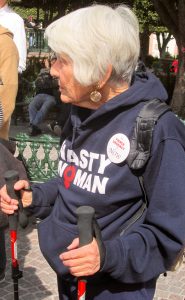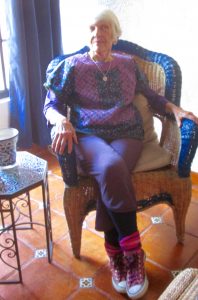The first time I noticed her, well before I met her, Patricia Browne Hirschl caught my attention at a political rally here in San Miguel de Allende, Mexico, three years ago this month because of the “Nasty Woman” hoodie she was wearing. (This, if you recall, was the term Donald Trump had used for Hillary Clinton at their third presidential debate in 2016, and it soon became a women’s rights rallying cry.) I had to take Pat’s picture. What spirit, I thought then. What spunk. What a woman!

Some time later, after I finally did meet Pat in a folk dancing class here, I realized my first impressions were correct. Pat (now 87) is a force. She’s not only a political activist but also an author, kayaker, stationary-biker, yoga practitioner, world traveler, and avid dancer. Her energy gives off sparks.
Pat is the author of the 2015 memoir, Winter Bloom: A Heart Warms in San Miguel, for which she used her maiden name, Patricia Jean Browne. (Available on Amazon.) It’s the story of Pat’s life, from her privileged childhood as the daughter of a prosperous family in the Midwest, to her early marriage and conventional Midwestern suburban life in the ‘50s, to the raising of her three children, her conversion to Judaism, and the slow disintegration of her nearly fifty-year marriage, before Pat decided to start a new life in San Miguel twenty years ago.
One reviewer called Winter Bloom “a coming-of-sage story that will resonate with many women in all cultures,” and I completely agree. Another reviewer said, “Men will also learn much from this woman’s story.”
In a recent interview in her home in San Miguel, Pat told me her book is “the story of my late-awakening.” She added, “The truth was, the marriage was hard. Leaving it was not hard. That’s good for other women to know.”

The book, Pat admits, took a total of fifteen years to write. “I had a lot of help,” she says, particularly from writer and book coach Judyth Hill, who urged her to go deeper and be utterly honest.
Pat refers to herself as “an intellectually curious retiree.” Over the years she’s been active in the League of Women Voters, San Miguel PEN, the American Civil Liberties Union, the Democratic Party, and various Jewish groups. She described a “Jewish syndrome” that “has nothing to do with the religion” but more to do with “intellectual curiosity — respect for education, for civil rights – the whole spectrum,” adding, “I feel much more comfortable being Jewish than I ever did being Catholic.”
At the end of Winter Bloom Pat provides an inspirational quote from Rabbi Yonassan Gershom’s 49 Gates of Light: Kabbalistic Meditations for Counting the Omer:
“If you could change the world, what would you do? Today, take one step toward putting your vision into action, keeping in mind that it is not for you to complete the work, but neither are you free to quit.”
But getting back to how we met in folk dance class a couple of years ago… Pat’s love of dance inspired me to return week after week.
As she says in Winter Bloom, “dance is a more reliable high for me than any drug.” And dancing had been a part of her life since she was four years old: dance class and recitals in her early youth, square dancing in high school, slow dancing with boyfriends, dancing on the beach, dancing with the kids, solo dancing at parties and bar/bat mitzvahs… Almost never with her husband, though.
Today, she says, dancing means even more to her than ever before. “I have arthritic knees,” she told me, “and that motivates me to move a lot because it’s the only remedy that I have found to be helpful.” She loves doing yoga and going kayaking on the nearby presa (lake) each week, but she enjoys the folk dance group most of all. She even travels to folk dance “camps” in various far-flung locales whenever she can.
This September, for example, one month before her eighty-eighth birthday, Pat plans to travel to Romania to attend a famous folk dance camp there. With characteristic spunk she adds, “It may not happen, but I’m going to try anyhow.”
